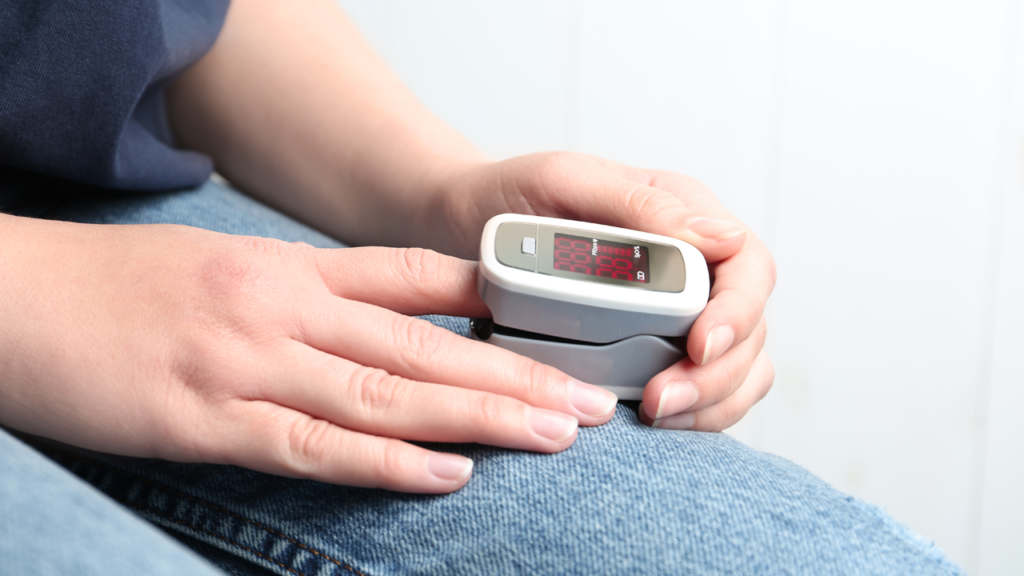Further information
Find out more about how AHSNs are supporting patient safety during Covid-19.
Read the rapid-learning report
The Health Innovation Network (HIN) has been commissioned to support a drive to equip members and partners to offer the Covid Oximetry @home model. This comes as treatment of Covid-19 improves and evidence has shown that earlier detection of (silent) hypoxia at home could help further reduce mortality and morbidity.
Detecting the early signs of deterioration in patients with confirmed or suspected Covid-19 is a significant challenge for health and social care teams. As patients at risk of poorer outcomes can be identified by reduced oxygen saturation levels, the ability to recognise early decreases in blood oxygen levels before the patient becomes symptomatic is vital.
Covid virtual ward models use pulse oximeters to safely monitor and support patients at home, providing an opportunity to detect a decline in the patient’s condition that might require hospital review and admission. Early experiences of implementing this approach have been linked to reduced mortality, hospital length of stay, and the number of patients requiring intensive care admission and ventilation.
Patient Safety Collaboratives are supporting the implementation of Covid virtual wards and the use of pulse oximeters in their local health and care systems, as part of the national Covid Oximetry @home model.
Pulse oximetry and remote monitoring guidance has been published by NHS England and NHS Improvement on pulse oximetry to detect early deterioration of patients with Covid-19 in primary and community care settings. It also includes a remote monitoring Covid-19 diary which patients can use to track their pulse oximeter readings.
What does this mean for patients?
General advice for anyone experiencing the symptoms of Covid-19 is available on the NHS website.
Health Education England has produced this animation which explains how to use pulse oximeters at home and keep a Covid-19 diary:
Learning network
Covid Oximetry @home is part of a range of NHS initiatives providing better connected, more personalised care in people’s homes, including care homes.
Resources for healthcare professionals are available in a dedicated online platform. It includes a toolkit with a wealth of additional resources. This summary sets out how to access the virtual ward toolkit and what’s included.
You will also be able to access webinar recordings and order oximeters through the platform. Learning Network meetings are held fortnightly on Tuesday afternoons from 3.30-4.30pm for members (8 December 2020).
Please get in touch with your local Patient Safety Collaborative to find out more.
This webinar explains how a virtual ward model with oximetry works, presented by Dr Matt Inada-Kim, National Deterioration Clinical Lead for NHS England and NHS Improvement:
Further resources
This paper on Virtual Wards, Silent Hypoxia and improving Covid outcomes was published by the Royal College of General Practitioners in October 2020.
This paper on the Validation of home oxygen saturations as a marker of clinical deterioration in patients with suspected Covid-19 considers whether the early identification of deterioration in suspected Covid-19 patients managed at home enables a more timely clinical intervention.
HSJ has published this set of resources on pulse oximetry as a Covid early warning system.
Taking oximetry observations is the subject of one of the care home staff training films created by Wessex and the West of England Academic Health Science Networks (AHSNs) and West Hampshire CCG, and funded by Health Education England. This series of free videos and e-learning materials is designed to support staff working in care homes to care for residents who are at risk of deterioration.
Listen to a podcast about our Oximetry @home and virtual wards work as part of our Annual Report 2020/21.
Find out more about how AHSNs are supporting patient safety during Covid-19.
Read the rapid-learning report